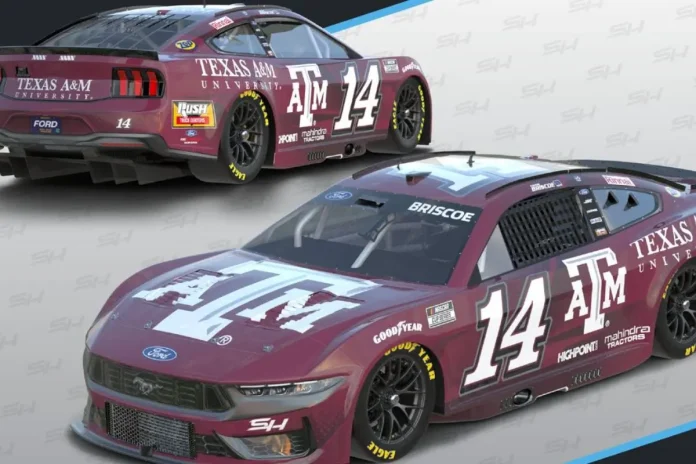Stewart-Haas Racing secured low-cost sponsorship during their final season as a full-time NASCAR team, and the deal raised some eyebrows. As the 2024 season wrapped up, SHR secured a sponsorship deal that brought in less money than expected. What caused this unexpected drop in funding?
Key Highlights
- Texas A&M sponsored Stewart-Haas cars for $160,000, a relatively low cost for NASCAR sponsorships.
- The partnership aimed to enhance Texas A&M’s brand presence and engage a diverse NASCAR fan base.
- The sponsorship included Aggies-themed liveries for races in Las Vegas and Phoenix.
- Benefits included digital outreach, social media engagement, and VIP access for networking.
- The deal reflects SHR’s financial state and the changing landscape of motorsports sponsorships.
Stewart-Haas Racing Partners with Texas A&M University
In a move to improve brand presence and capitalize on the synergy between academia and motorsports, Stewart-Haas Racing entered into a sponsorship agreement with Texas A&M University for the final races of their 2024 NASCAR Cup Series campaign.
This partnership comes as Stewart-Haas Racing (SHR) approaches the finale of their tenure as a full-time, four-car team in the NASCAR Cup Series. The collaboration is indicative of a strategic shift, seeking to utilize the mutual benefits of exposure and alignment with a prestigious educational institution known for its robust engineering programs and passionate alumni network.
The partnership was manifested through Aggies-inspired liveries, prominently displayed on the cars of Chase Briscoe and Josh Berry during crucial races at Las Vegas and Phoenix.
This initiative not only provided Texas A&M with a unique platform to reach a diverse and dedicated fan base but also allowed Stewart-Haas Racing to introduce fresh energy into their branding efforts as they evolve into a new phase of their motorsports experience.

Details of the Texas A&M Sponsorship Agreement
Texas A&M’s collaboration with Stewart-Haas Racing marked a notable venture into the world of NASCAR sponsorship, characterized by a $160,000 investment to become the primary sponsor for two vital races. This tactical move was revealed by the university as a “novel” marketing effort, highlighting the institution’s intent to harness the NASCAR platform’s extensive reach.
“Texas A&M University agreed to spend $160,000 to be the primary sponsor of Stewart-Haas cars at two NASCAR races, a marketing partnership that the school called ‘novel’ during its original announcement,”
“The contract, a copy of which Sportico obtained via open records requests, was signed by both sides in early October. For a final cost of no more than $160,000, Stewart-Haas agreed to race twice with Texas A&M-branded liveries, plus a handful of other marketing, promotional and ticket deliverables.”
“Chase Briscoe raced his No. 14 car with a maroon Texas A&M wrap in Las Vegas on Oct. 20, and his teammate Josh Berry drove his No. 4 car with a maroon and camouflage wrap at Phoenix.” – as per Jayski report
The agreement, finalized in early October, required Stewart-Haas Racing to feature Texas A&M-branded liveries prominently on their vehicles, an arrangement that emphasizes the synergy between motorsports and collegiate branding.
The sponsorship’s tangible execution saw Chase Briscoe’s No. 14 car adorned in a distinctive maroon Texas A&M wrap during the Las Vegas race on October 20. Concurrently, Josh Berry piloted his No. 4 car with a unique maroon and camouflage design at the Phoenix event. This visual branding not only raised Texas A&M’s visibility among NASCAR’s vast audience but also symbolized the university’s creative approach to marketing.
Additional Benefits for Texas A&M
Beyond the visible branding on Stewart-Haas Racing’s cars, the sponsorship agreement provided Texas A&M with a suite of supplementary benefits, enhancing the university’s engagement with NASCAR’s fanbase. Significantly, the contract included a tactical element of digital outreach, as Stewart-Haas Racing was tasked with producing a minimum of four Texas A&M-specific social media posts during race weekends. This digital visibility is essential, given NASCAR’s robust online community, and it allows Texas A&M to tap into demographics beyond traditional academic circles, engaging a varied audience passionate about motorsports.
Moreover, the agreement stipulated that Stewart-Haas Racing would tag Texas A&M in all race-related social media posts. This guarantees continuous exposure and integration of the university’s brand across multiple digital platforms, reinforcing its presence in the NASCAR community. This seamless digital engagement not only boosts brand awareness but also presents Texas A&M as a creative institution willing to investigate unconventional marketing avenues.
Alongside digital perks, Texas A&M secured physical access to the NASCAR environment by acquiring 20 complimentary VIP full-access credentials for each race. This provision enables the university to forge relationships and create a networking hub with NASCAR stakeholders, sponsors, and fans.
The VIP access provides unique opportunities for Texas A&M to host alumni, prospective students, and partners, fostering a sense of community and connection within the exhilarating setting of NASCAR races. This multi-faceted approach emphasizes Texas A&M’s tactical intent to utilize its motorsports engagement for broader institutional benefits, positioning it as a forward-thinking entity in the domain of sports sponsorship.
Speculation About the Low Cost of Sponsorship
How did Texas A&M manage to secure such a surprisingly low-cost sponsorship deal with Stewart-Haas Racing? The $160,000 expenditure presents an anomaly in the high-stakes world of NASCAR sponsorships, where figures typically soar into the millions. Observers have likened this agreement to a “going-out-of-business sale,” a sentiment echoed by driver Chase Briscoe’s frank confirmation on Reddit. This low-cost entry allowed Texas A&M to gain exposure in regions beyond their traditional reach, a tactical win for the university.
The timing of the deal, coinciding with Stewart-Haas Racing’s impending shift away from full-time NASCAR Cup Series participation, likely played a critical role. When a team faces financial uncertainty or seeks to fill sponsorship gaps quickly, reduced pricing can be a tactical necessity. The scarcity of sponsors in the market likely improved Texas A&M’s negotiating position.
Given these factors, the Aggies may have capitalized on a rare alignment of circumstances—opportunities like this are seldom repeated in NASCAR’s competitive landscape. The real question remains whether Texas A&M will reappear on the NASCAR circuit, and if so, whether the financial landscape will allow them such advantageous terms again. This deal stands as a reflection of the unpredictability and tactical insight required in motorsports sponsorship negotiations.
News in Brief: Stewart-Haas Racing Secured Low-Cost Sponsorship
The partnership between Stewart-Haas Racing and Texas A&M University represents a calculated collaboration in the motorsports industry, offering mutual promotional benefits. The $160,000 sponsorship cost is remarkably low, prompting speculation regarding underlying negotiations and potential long-term objectives.
This move could boost Texas A&M’s visibility in a new demographic, while Stewart-Haas Racing gains academic and institutional affiliations. The agreement highlights the evolving dynamics of sponsorship in NASCAR, where educational institutions increasingly recognize the marketing potential of motorsport collaborations.




